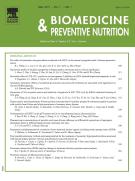Biosynthesis of gold nanoparticles using Solanum nigrum leaf extract and screening their free radical scavenging and antibacterial properties - 30/05/14


Abstract |
Development of environmentally benign biological process for the synthesis of nanoparticles is one of the important areas of research in nanotechnology. In the present study, gold nanoparticles (Au-NPs) were synthesized at room temperature using Solanum nigrum (S. nigrum) leaf extract as reducing agent. The gold nanoparticles obtained were characterized by UV–visible spectroscopy, dynamic light scattering (DLS), zeta potential (ZP), transmission electron microscopy (TEM), X-ray diffraction (XRD) and Fourier transform infrared (FT-IR) spectroscopy. The Au-NPs formation was confirmed by UV–visible spectroscopy through color conversion due to surface plasma resonance band at 537nm. DLS studies revealed that the average size of Au-NPs was found to be around 50nm. Zeta potential value for Au-NPs obtained was −17.80mV indicating the moderate stability of synthesized nanoparticles. Crystalline nature of the Au-NPs in face centered cubic structure is evident from the selected area electron diffraction (SAED) and XRD pattern. FT-IR spectrum identifies the presence of different biomolecules in the S. nigrum leaf extract responsible for the reduction and stabilization of Au-NPs. The biomedical properties of Au-NPs were premeditated as free radical scavenging activity and antibacterial static agents. Biosynthesized Au-NPs showed a strong DPPH radical and hydroxyl radical scavengers compared to the aqueous leaf extract of S. nigrum. Furthermore, the biosynthesized Au-NPs significantly inhibited the growth of medically important pathogenic gram-positive bacteria (Staphylococcus saprophyticus and Bacillus subtilis) and gram-negative bacteria (Escherichia coli and Pseudomonas aeruginosa). The report suggests that the biosynthesized gold nanoparticles could have a high potential for use in the preparation of drugs used against various diseases and also promising candidate for many medical applications.
Le texte complet de cet article est disponible en PDF.Keywords : Gold nanoparticles, Biosynthesis, Solanum nigrum, Free radical scavenging, Antibacterial activity
Plan
Vol 4 - N° 2
P. 325-332 - avril 2014 Retour au numéroBienvenue sur EM-consulte, la référence des professionnels de santé.
L’accès au texte intégral de cet article nécessite un abonnement.
Déjà abonné à cette revue ?

